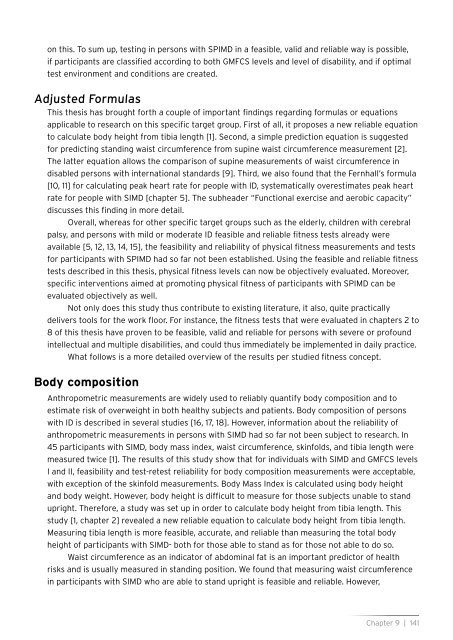Measuring physical fitness in Persons with Severe/Profound ...
Measuring physical fitness in Persons with Severe/Profound ...
Measuring physical fitness in Persons with Severe/Profound ...
- No tags were found...
You also want an ePaper? Increase the reach of your titles
YUMPU automatically turns print PDFs into web optimized ePapers that Google loves.
on this. To sum up, test<strong>in</strong>g <strong>in</strong> persons <strong>with</strong> SPIMD <strong>in</strong> a feasible, valid and reliable way is possible,if participants are classified accord<strong>in</strong>g to both GMFCS levels and level of disability, and if optimaltest environment and conditions are created.Adjusted FormulasThis thesis has brought forth a couple of important f<strong>in</strong>d<strong>in</strong>gs regard<strong>in</strong>g formulas or equationsapplicable to research on this specific target group. First of all, it proposes a new reliable equationto calculate body height from tibia length [1]. Second, a simple prediction equation is suggestedfor predict<strong>in</strong>g stand<strong>in</strong>g waist circumference from sup<strong>in</strong>e waist circumference measurement [2].The latter equation allows the comparison of sup<strong>in</strong>e measurements of waist circumference <strong>in</strong>disabled persons <strong>with</strong> <strong>in</strong>ternational standards [9]. Third, we also found that the Fernhall’s formula[10, 11] for calculat<strong>in</strong>g peak heart rate for people <strong>with</strong> ID, systematically overestimates peak heartrate for people <strong>with</strong> SIMD [chapter 5]. The subheader “Functional exercise and aerobic capacity”discusses this f<strong>in</strong>d<strong>in</strong>g <strong>in</strong> more detail.Overall, whereas for other specific target groups such as the elderly, children <strong>with</strong> cerebralpalsy, and persons <strong>with</strong> mild or moderate ID feasible and reliable <strong>fitness</strong> tests already wereavailable [5, 12, 13, 14, 15], the feasibility and reliability of <strong>physical</strong> <strong>fitness</strong> measurements and testsfor participants <strong>with</strong> SPIMD had so far not been established. Us<strong>in</strong>g the feasible and reliable <strong>fitness</strong>tests described <strong>in</strong> this thesis, <strong>physical</strong> <strong>fitness</strong> levels can now be objectively evaluated. Moreover,specific <strong>in</strong>terventions aimed at promot<strong>in</strong>g <strong>physical</strong> <strong>fitness</strong> of participants <strong>with</strong> SPIMD can beevaluated objectively as well.Not only does this study thus contribute to exist<strong>in</strong>g literature, it also, quite practicallydelivers tools for the work floor. For <strong>in</strong>stance, the <strong>fitness</strong> tests that were evaluated <strong>in</strong> chapters 2 to8 of this thesis have proven to be feasible, valid and reliable for persons <strong>with</strong> severe or profound<strong>in</strong>tellectual and multiple disabilities, and could thus immediately be implemented <strong>in</strong> daily practice.What follows is a more detailed overview of the results per studied <strong>fitness</strong> concept.Body compositionAnthropometric measurements are widely used to reliably quantify body composition and toestimate risk of overweight <strong>in</strong> both healthy subjects and patients. Body composition of persons<strong>with</strong> ID is described <strong>in</strong> several studies [16, 17, 18]. However, <strong>in</strong>formation about the reliability ofanthropometric measurements <strong>in</strong> persons <strong>with</strong> SIMD had so far not been subject to research. In45 participants <strong>with</strong> SIMD, body mass <strong>in</strong>dex, waist circumference, sk<strong>in</strong>folds, and tibia length weremeasured twice [1]. The results of this study show that for <strong>in</strong>dividuals <strong>with</strong> SIMD and GMFCS levelsI and II, feasibility and test-retest reliability for body composition measurements were acceptable,<strong>with</strong> exception of the sk<strong>in</strong>fold measurements. Body Mass Index is calculated us<strong>in</strong>g body heightand body weight. However, body height is difficult to measure for those subjects unable to standupright. Therefore, a study was set up <strong>in</strong> order to calculate body height from tibia length. Thisstudy [1, chapter 2] revealed a new reliable equation to calculate body height from tibia length.<strong>Measur<strong>in</strong>g</strong> tibia length is more feasible, accurate, and reliable than measur<strong>in</strong>g the total bodyheight of participants <strong>with</strong> SIMD- both for those able to stand as for those not able to do so.Waist circumference as an <strong>in</strong>dicator of abdom<strong>in</strong>al fat is an important predictor of healthrisks and is usually measured <strong>in</strong> stand<strong>in</strong>g position. We found that measur<strong>in</strong>g waist circumference<strong>in</strong> participants <strong>with</strong> SIMD who are able to stand upright is feasible and reliable. However,Chapter 9 | 141











